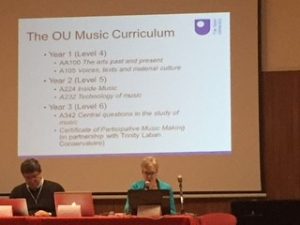Last week Naomi Barker was invited to Milan to give a paper on at a conference on distance learning in music education. She presented a paper on learning music theory at a distance, using A224 and the OU music MOOC as exemplars. The meeting was organised by InterMusic, a European initiative to develop online and distance learning for musicians. Funded by ERASMUS+, InterMusic is a partnership between the G. Verdi Conservatoire of Music in Milan, Milan Polytechnic, the Royal Danish Academy of Music in Copenhagen,and the Lithuanian Academy of Music in Vilnius.
The creative industries are on the European agenda, so there is substantial political and financial incentive for institutions to create distance learning programmes. European universities and conservatoires have recognised the need for providing accessible music education at a distance and are eager to learn how to do so effectively. They know that the OU reaches hundreds of music students every year through its degree programmes and thousands more through its open access materials. The OU Music MOOC ‘From notation to performance: understanding musical scores’, for example, has reached over 21,000 students to date. Each of the partner institutions in the InterMusic project is developing specialist online distance learning courses, and they want to know how we at the OU deliver our music programme. There is a great deal to celebrate in knowing that the OU is held up as a global leader in distance education for music.
Many of the participating European institutions are carrying out exciting research into how new digital technologies can be used to teach music. Among these are platforms enabling simultaneous performance by musicians in different countries. It’s not just in the field of performance that new technology is emerging, however. One institution is developing software that reacts to creative compositional inputs for teaching harmony and theory, another is working on software that ‘listens’ to a model and ‘learns’ how to improvise, and a third has already created computer programmes that speed up ear training. The possibilities are many, and all of them seem to be achievable within the next two or three years. Given the OU’s place at the forefront of distance education in music, there are significant possibilities for partnerships and collaborations which will benefit our students in the future. Watch this space!
